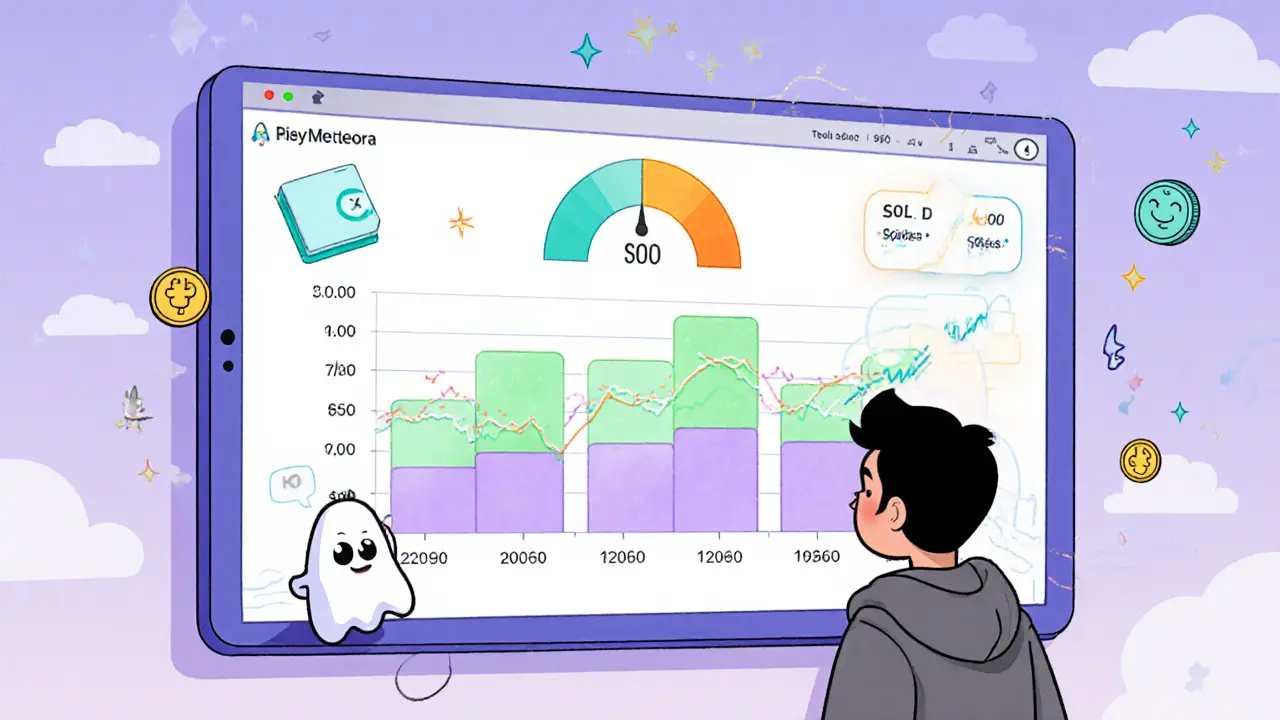
- 10 Oct 2025
- Elara Crowthorne
- 9
Meteora DAMM v2 Fee Calculator
Simulate how Meteora DAMM v2 adjusts fees based on market volatility. Set the current volatility level and see the resulting fee percentage.
Estimated LP Earnings
With a 25% fee rate, LPs can potentially earn 15-30% of total trading fees during high volatility periods.
How Volatility Affects Trading
When volatility is low, fees remain near 0% to encourage trading activity. As volatility increases, fees spike to 50% to reward LPs for providing liquidity during turbulent times.
Fee Range Breakdown:
- 0-10% Volatility: 0% fee (encourages trading)
- 10-30% Volatility: 10-25% fee (moderate reward)
- 30-50% Volatility: 25-50% fee (maximum reward)
Key Takeaways
- Meteora DAMM v2 combines dynamic fees with a bin‑based liquidity model to reward LPs during high volatility.
- Dynamic fees can swing from 0% up to 50%, which boosts LP earnings but can deter traders when markets are choppy.
- Average spread sits at ~0.66% - slightly higher than Raydium but still competitive within Solana DEXs.
- Learning curve is steep; beginners should start with small positions and focus on major pairs like SOL/USDC.
- Upcoming MET token launch and cross‑chain roadmap aim to broaden the protocol’s appeal beyond niche LPs.
Meteora DAMM v2 is a decentralized exchange protocol built on the Solana blockchain that uses a Dynamic Automated Market Maker (DAMM) model to adjust fees based on real‑time volatility. Launched in 2023 and upgraded to version 2 in early 2024, the platform promises higher returns for liquidity providers (LPs) when markets swing wildly.
What Sets Meteora Apart?
Most Solana DEXs-Raydium, Orca, Jupiter-run a classic AMM that charges a fixed fee (usually 0.25%‑0.3%). Dynamic fee structure on Meteora automatically scales from 0% to 50% depending on the volatility of the pool. When a sudden price move hits, the fee spikes, diverting a larger slice of each trade to LPs. As the market calms, the fee decays back toward zero, encouraging more trading activity.
Another differentiator is the bin‑based liquidity system that lets providers allocate assets into discrete price bins rather than a single continuous curve. Think of it as Uniswap V3’s concentrated liquidity, but with the added ability to shift liquidity between bins automatically as volatility forecasts change.
How It Works - Step‑by‑Step
- Connect a Solana‑compatible wallet (Phantom, Backpack, or Solflare). Phantom wallet is the most popular choice for Solana DeFi interactions.
- Select a pool. The platform lists 158 tokens across 648 pairs; the most liquid is SOL/USDC pair, accounting for about 37% of total volume.
- Choose price bins. Beginners usually start with a narrow range around the current market price; advanced users may spread across multiple bins to capture larger swings.
- Deposit the minimum required (often 0.01SOL equivalent) and confirm the transaction.
- Monitor volatility indicators (e.g., on‑chain price feeds, TVL spikes). Fees will adjust automatically; you can re‑balance bins manually if you want to chase a new range.

Performance Snapshot (Oct2024)
According to CoinGecko data, Meteora ranks in the 86th percentile for trading volume among all DEXs and 72nd for order‑book depth. The average bid‑ask spread is 0.656%, compared with Raydium’s 0.48% on similar pairs. Fee earnings for LPs in volatile pools have been reported between 15%‑50% of total fees over a week, dwarfing the sub‑1% returns typical on static‑fee AMMs.
Pros and Cons
- Pros
- Potentially massive LP rewards during spikes (up to 50% fee capture).
- Bin‑based liquidity lets you concentrate capital where you expect price movement.
- Fully decentralized-no custodial risk.
- Cons
- Steep learning curve; mis‑configured bins can lead to high impermanent loss.
- High fees may discourage traders, reducing overall volume in extreme scenarios.
- Medium trust score (5/10) on CoinGecko due to limited track record.
How It Stacks Up Against Competitors
| Feature | Meteora DAMM v2 | Raydium | Uniswap V3 |
|---|---|---|---|
| Blockchain | Solana | Solana | Ethereum (and L2s) |
| Fee Model | Dynamic 0‑50% based on volatility | Fixed 0.25% (or 0.2% for certain pools) | Fixed tiers (0.01%, 0.05%, 0.30%, 1%) |
| Liquidity Style | Bin‑based, auto‑adjusting | Concentrated liquidity (manual) | Concentrated liquidity (manual) |
| Typical Spread | ~0.66% | ~0.48% | ~0.30%‑0.45% (varies by pool) |
| LP Return in Volatile Markets | 15‑50% of fees over a week | 0.3‑1% of fees | 0.3‑1% of fees |
| Governance Token | MET (TGE Q12025) | RAY | UNI |

Getting Started - A Quick Checklist
- Install Phantom browser extension wallet for Solana and fund it with SOL.
- Navigate to the Meteora interface (app.meteora.ag).
- Pick a high‑volatility pool (e.g., SOL/USDC or newly listed meme tokens).
- Set your price range bins - start narrow (±2‑3%) if you’re new.
- Deposit the minimum amount, confirm, and watch the fee meter adjust in real time.
Risks & Mitigation Strategies
Because fees can jump to 50%, traders may avoid the pool during spikes, leaving LPs with lower turnover. To offset this, many providers split capital across multiple bins and periodically re‑balance when volatility forecasts shift.
Impermanent loss is another concern. A simple rule of thumb: never allocate more than 10‑15% of your total DeFi budget to a single volatile DAMM v2 pool until you’ve mastered bin placement.
Regulatory risk remains low for now-the protocol is fully permissionless-but should any jurisdiction clamp down on ultra‑high‑fee models, the code can be forked and redeployed elsewhere.
Future Outlook
The upcoming MET token distribution aims to reward early LPs and NFT holders, which could spark a wave of new liquidity. Additionally, the September2024 volatility‑forecast upgrade cut false fee spikes by 37%, making the platform more trader‑friendly.
Roadmap items like integration with Firedancer validators and a cross‑chain bridge to Ethereum L2s by Q32025 suggest Meteora is betting on scalability beyond Solana. Analysts at Delphi Digital project that adaptive‑fee DEXs could command up to 20% of total DEX volume by the end of 2025 if they keep improving user experience.
Bottom line: if you’re comfortable tweaking bins and can tolerate occasional high fees, Meteora DAMM v2 offers some of the highest LP yields in the current DeFi landscape. If you prefer a set‑and‑forget approach, you might stay with Raydium or Orca until you’ve built enough confidence.
Frequently Asked Questions
What is the main advantage of Meteora’s dynamic fee?
The dynamic fee automatically scales with market volatility, so LPs capture a larger share of trading fees when price swings are sharp. This can translate into 10‑50% higher fee earnings compared to static‑fee AMMs.
Do I need to hold MET to provide liquidity?
No. Liquidity can be supplied using any supported token pair (e.g., SOL/USDC). MET is a governance token slated for a 2025 launch and will be used for voting and future incentives.
How steep is the learning curve?
Surveys show about 78% of newcomers find bin management tricky. Expect to spend 15‑20 hours learning the UI, reading docs, and testing with tiny positions before committing larger capital.
Can I use a wallet other than Phantom?
Yes. Backpack, Solflare, and Torus are all compatible with the Meteora interface. Just make sure the wallet supports SOL and the SPL token standard.
What happens if the fee spikes to 50%?
Traders will see a very high cost per swap, which often pushes them to other DEXs. LPs, however, receive a large portion of those fees, boosting their returns-provided the price move continues to generate volume.


9 Comments
Jumping into Meteora? Start by connecting your Phantom wallet, pick the SOL/USDC pool, and set a tight ±2‑3% price bin – that’s the sweet spot for newbies.
Keep the initial deposit tiny, like 0.01 SOL, so you can feel the fee swings without risking much.
Watch the volatility slider; when it creeps above 20 % you’ll see fees spike toward 25‑30 % and LP earnings jump.
Don’t forget to rebalance your bins after a big price move – a quick 5‑minute check keeps you in the profit zone.
Most importantly, treat the dynamic fees as a bonus, not a trap; the DEX still needs traders to generate those fees.
From a liquidity‑efficiency perspective, Meteora’s bin‑based architecture mirrors Uniswap V3’s concentrated liquidity but augments it with an auto‑rebalancing layer driven by on‑chain volatility metrics.
The dynamic fee curve (0‑50 %) serves as a market‑maker incentive mechanism, aligning LP capital deployment with periods of high order‑book depth volatility.
In practice, you’ll observe a positive correlation between TVL spikes and fee‑rate elasticity, which can be back‑tested via the platform’s fee‑simulator API.
When configuring bins, aim for a price range that captures at least 80 % of the historic price distribution to minimize impermanent loss under stochastic shocks.
Overall, the protocol’s design reduces slippage while rewarding LPs during turbulence, positioning it as a sophisticated tool for capital‑efficient arbitrage.
Dynamic fees sound fancy but they can scare off casual traders 😐 low vol means zero fees so you get cheap swaps however when volatility spikes fees rocket up to 50 % which is insane for a regular user.
It’s infuriating to see a US‑based DeFi platform incentivizing astronomically high fees – it feels like a predatory scheme 🇺🇸💥.
We should demand transparent fee caps that protect everyday investors.
Otherwise, we’re just rewarding whales while the little guy gets burnt.
Ah, the grand theater of Meteora’s fee ballet – a dazzling display of algorithmic bravado that would make a Shakespearean troupe blush.
Every time the market flutters, the protocol flings a 0‑to‑50 % fee like confetti at a royal wedding.
One must applaud the audacity, yet also recognize the underlying peril for the modest trader who suddenly faces a half‑century surcharge.
It’s a masterclass in risk‑reward engineering, but only the intrepid survive the spectacle.
In short, it’s poetry in motion; just don’t mistake it for a lullaby.
You’re missing the point, Ethan – the “poetry” you romanticize is just a veneer over a fee extraction engine that leeches LP capital during volatility spikes. The jargon about “risk‑reward engineering” masks the fact that most users get sandwiched by widening spreads and an exploding fee curve. If you think this is art, you’ve never watched a trader’s ROI dissolve in seconds. 🎭
Dear community, the structural composition of Meteora’s dynamic fee mechanism warrants a meticulous examination, particularly in regard to its impact on market liquidity and trader welfare.
That said, let’s be real – those fee spikes can feel like a surprise exam you didn’t study for. So keep an eye on the volatility bar and don’t get caught off guard.
Meteora’s bin system lets you stack capital where you expect moves, and the dynamic fee cranks up when the market shakes – simple profit hack.
For anyone uneasy about the 50 % fee ceiling, consider splitting your liquidity across multiple bins with staggered ranges; this spreads risk and smooths out fee capture.
Also, monitor the on‑chain volatility index displayed in the UI; when it hovers above 30 % it’s a cue to tighten your range.
Finally, remember that fees revert to near‑zero in calm periods, so you’ll still earn during low‑vol phases.